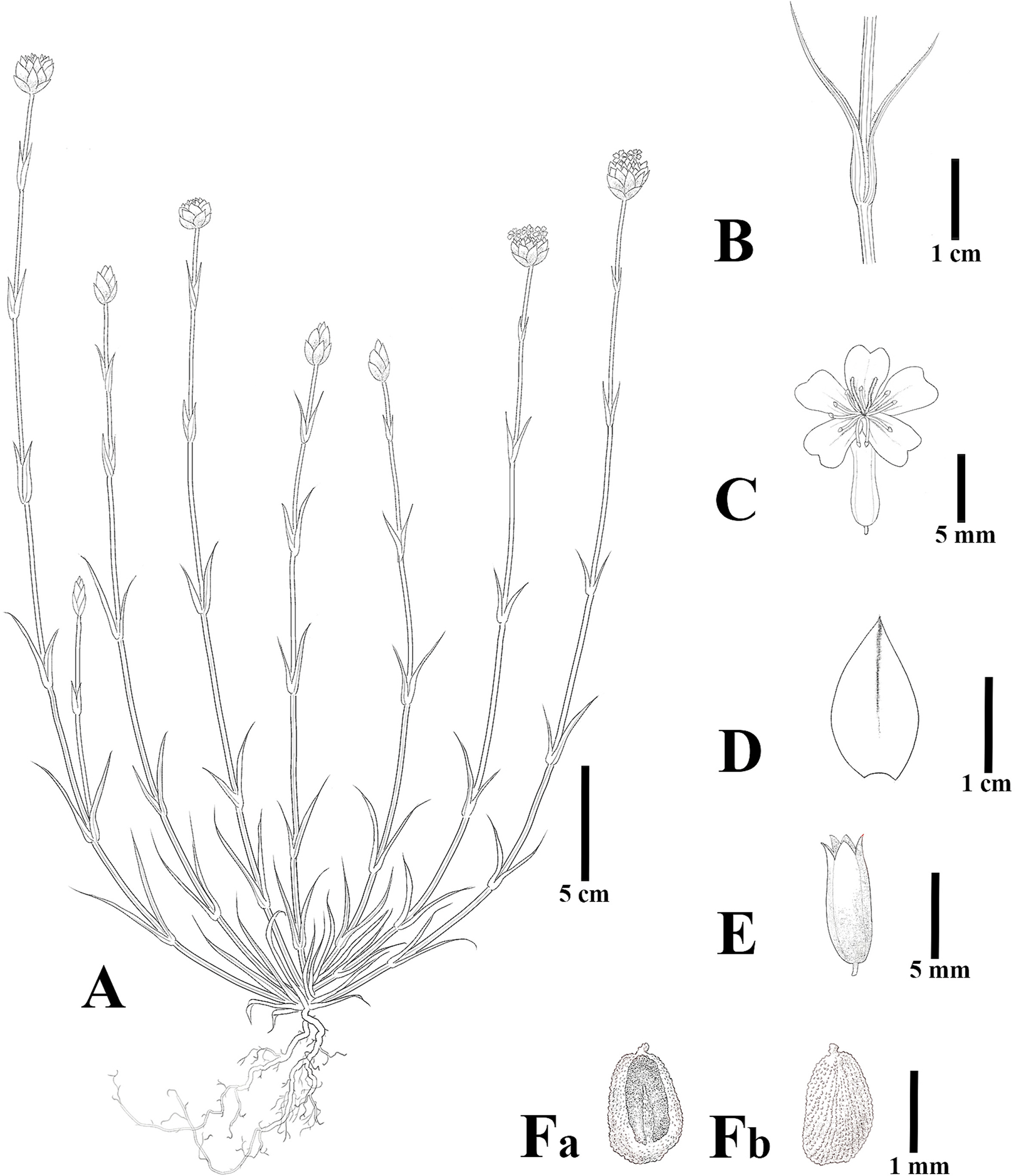Caryophyllaceae Juss., include approximately 3,000 species in about 100 genera (Hernández-Ledesma et al., 2015). The family has a primarily North Temperate distribution and a diversity center in the eastern Mediterranean and Irano-Turanian regions. Its presence in the tropics and the southern hemisphere is limited and mostly confined to higher elevations (Bittrich, 1993; Rabeler and Hartman, 2005; Greenberg and Donoghue, 2011). Approximately 86 species of Caryophyllaceae, distributed among 17 genera (Hong and Choi, 2018), are in Korea. Kang et al. (2020) have reported 619 alien plants in Korea, including 21 taxa in the Caryophyllaceae.
Petrorhagia (Ser.) Link is a genus of 33 species distributed in the Mediterranean region, Europe and Western Asia (Ball and Heywood, 1964; Rabeler, 1985). In the past, it was considered to be part of such genera as Dianthus L., Gypsophila L., Kohlrauschia Kunth, and Tunica Scop. (Trigas et al., 2018). Evidence from both traditional and phylogenetic systematics supports its recognition as a distinct genus which is sister to a clade including Dianthus and Velezia L. (Ball and Heywood, 1964; Rabeler and Hartman, 2005; Greenberg and Donoghue, 2011; Trigas et al., 2018).
We here report the first occurrence of Petrorhagia, represented by P. nanteuilii in Korea (Figs. 1, 2). The Korean name for the genus is given as ‘Pae-raeng-i-a-jae-bi-sok’.
During a field survey of plant diversity in Gyeongsangnam-do, we found the unrecorded alien plant, Petrorhagia nanteuilii, in abandoned fields and roadsides in Goseong-gun, Korea. We here provide a description, illustrations, a taxonomic key to related taxa as well as habitat details.
Taxonomic Treatment
Description of the genus
Petrorhagia
(Ser.) Link, Handbuch 2: 235, 1831; Gypsophila sect. Petrorhagia Ser. in DC., Prodr. 1: 354, 1824.
Type species: Petrorhagia saxifraga (L.) Link, Handbuch 2: 235, 1831.—TYPE: not cited.
Korean name: Pae-raeng-i-a-jae-bi-sok (패랭이아재비속).
Herbs, annual or perennial, hermaphroditic, dioecious or gynodioecious. Stems erect or ascending, simple or branched, sometimes proximally woody. Leaves opposite, simple, sessile; blade linear to narrowly oblanceolate, apex acute, margins entire, both surfaces glabrous or scabrous, 1- or 3-veined. Inflorescences terminal, dense capitula or lax cymes or flowers solitary; bracts paired, often enclosing inflorescence; involucel bracteoles of 1–4 pairs or rarely absent. Flowers bisexual or unisexual; sepals basally connate, forming a tube, cylindrical, 15-veined, green or reddish and white or brown, scarious; lobes green, reddish, or brown, 3-veined, oblong, shorter than tube, margins white or brown, scarious, apex rounded; petals 5, pink, purplish or white, clawed, auricles absent, coronal appendages absent, apex entire, obtuse or 2-fid; stamens 10; filaments distinct; staminodes absent; ovary 1-locular; styles 2; filiform; stigmas 2, linear, along adaxial surface of styles, papillate. Fruit capsules, 4-lobed, oblong, shorter than sepals. Seeds 8–15, blackish brown, shield- or helmet-shaped, dorsiventrally compressed, reticulate or papillate, marginal wing absent, embryo central, straight.
Key to Petrorhagia and related taxa in Korea
1. Bracts absent at base of calyx ··· Gypsophila 대나물속
1. Bracts present at base of calyx.
2. Commissures between adjacent sepals present; veins per sepal 1–3 ············
Petrorhagia 패랭이아재비속
2. Commissures between adjacent sepals absent; veins per sepal 5 or more ··············· Dianthus 패랭이꽃속
Description of the species
Petrorhagia nanteuilii
(Burnat) P. W. Ball & Heywood, Bull. Brit. Mus. (Nat. Hist.), Bot. 3: 164, 1964; Dianthus nanteuilii Burnat, Fl. Alpes Marit. 1: 221, 1892 (Figs. 1, 2).— TYPE: not cited.
Korean name: Pae-raeng-i-a-jae-bi (패랭이아재비).
Herbs, annual, 20–50 cm tall, glabrous, or partly tomentose. Stems erect, simple or branched; internodes glabrous or mid stem and proximal ones minutely stipitate glandular. Leaves opposite, simple, sessile; blade linear, 1–3 cm long, apex acute, margins scabrous, 3-veined; sheath 1–2(−3) mm long, 1.5–2 times longer than wide. Inflorescences terminal, capitate; inflorescence bracts and involucel bracteoles enclosing flowers, broadly ovate, brown scarious, apex of outer bracts mucronate, inner bracts obtuse or mucronate; pedicels 0.1–2 mm long. Flowers: calyx 5–10 mm long, calyx-lobes obtuse, membranous; petals pink or purplish, 5–10 mm long, primary veins 3, central vein darkly colored near base of blade, apex obcordate or 2-fid; stamens 10, slightly exserted; styles 2, exserted. Capsules ellipsoid-ovoid, ca. 6 mm long. Seeds brownish black, shield shaped, 1–1.5 mm long, tuberculate.
Flowering: May to June.
Fruiting: June to July.
Distribution: Korea, Asia, Australia, South America, western Europe, western North Africa
Specimens examined: KOREA. Gyeongsangnam-do: Goseong-gun, Goseong-eup, Su-nam-ri, 13 Jun 2020, Hyun Sik Kim KIMJH20155, KIMJH20156, KIMJH20157, KIMJH20158 (KB); same locality, 17 Jun 2021, Jung-Hyun Kim & Seog woo Kwon KIMJH21089, KIMJH21090, KIMJH21091, KIMJH21092, KIMJH21093, KIMJH21094 (KB); same locality, 20 Jun 2021, Sang Deog Shim & Hyun Sik Kim KIMJH21095, KIMJH21096, KIMJH21097 (KB).
Notes: Petrorhagia nanteuilii is native in western Europe and western North Africa, whereas it is an alien in South America, Australia, and Japan (Osada, 1972, 1989; Auld et al., 2003; Shimizu, 2003; Rabeler and Hartman, 2005). It may be an alloploid derived through hybridization between P. prolifera and P. dubia in Europe (Thomas and Murray, 1983). We first found P. nanteuilii on roadsides in Goseong-gun, Gyeongsangnam-do, in Korea in 2019 and confirmed its presence during the flowering seasons of 2020 and 2021. The population was composed of 2,000 individuals within an area of 50 × 20 m2. The canopy vegetation included Ulmus pumila L.; the herbaceous vegetation was made up of Stellaria alsine var. undulata (Thunb.) Ohwi, Lespedeza cuneata (Dum. Cours.) G. Don., Medicago lupulina L., Vicia sativa subsp. nigra (L.) Ehrh., Oenothera biennis L., Erodium cicutarium Willd., Torilis japonica (Houtt.) DC., Metaplexis japonica (Thunb.) Makino, Amethystea caerulea L., Veronica persica Poir., Bidens pilosa L., Coreopsis lanceolate L., Erigeron annuus (L.) Pers., Bromus japonicas Thunb., Eragrostis curvula (Schrad.) Nees, and Setaria viridis (L.) P. Beauv.
Thousands of individuals of Petrorhagia nanteuilii now grow at high density in the site where it was found. Additional populations will probably be discovered. According to the invasive grades (Table 1) categorized by Jung et al. (2016), P. nanteuilii is classified as a potential invasive species, since no additional sites have been found. Nevertheless, considering its population size and rate of seed set, a grade adjustment may be necessary in the future due to its spread.













